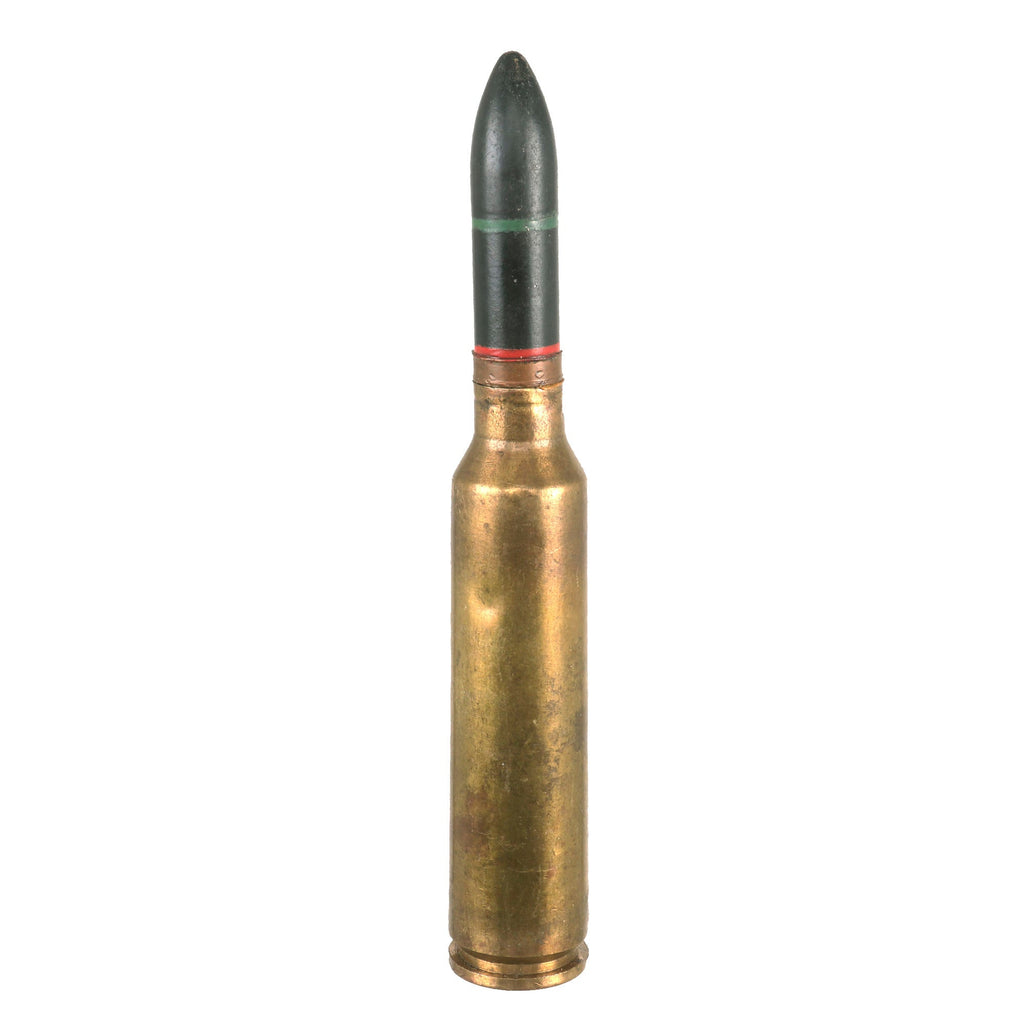Item Description
Original Item: Only One Available. This is an very nice inert demilitarized genuine Japanese WWII Type 100 20mm solid-steel armor-piercing (AP) Anti-Tank Round for the Japanese Type 97 Automatic Cannon / Anti-tank rifle. It looks to be the first version of the AP round, without the enlarged nose for better penetration. It comes complete in its brass casing. We unfortunately cannot remove it to see if it is a tracer round, and the color codes look to have been repainted.
The round is totally inert and unable to be used as a destructive device, making this item totally compliant per the current BATF standards governing ordnance.
Not Available For Export
A great example of an inert armor piercing cartridge from a rare Japanese Anti-Tank rifle. Ready to display!
The Type 97 automatic cannon was a 20-millimeter (0.79 in) Japanese anti-tank rifle that began development in the 1930s. It was used by the Imperial Japanese Army (IJA) during the Second Sino-Japanese War, the Soviet–Japanese border conflicts and the Pacific War. Ever-greater thicknesses of armor on tanks rendered the Type 97 obsolete by about 1942.
Production of the Type 97 began in 1939 at the Kokura Arsenal with the first of 950 that were made through 1941. Production ceased that year, although a further 100 rifles were built by the Nihon Seikosho Company in the first half of 1943. Including prototypes, a total of 1,108 rifles were manufactured. The anti-tank rifle cost ¥6,400 at a time when a normal rifle cost ¥77. Beginning in 1940, the barrels were chrome-plated to extend their lives.
The Type 97 was assigned to IJA infantry battalions, normally on the basis of a single anti-tank platoon allocated to each infantry company. Each platoon had two 11-man sections each with a single Type 97. In addition to the section leader, there were four men assigned to carry the gun, four ammunition bearers and two horse-holders for the nine horses nominally assigned to the section. Over long distances, the Type 97 was broken down into three parts to be carried by the horses.
The weapon first saw combat during the Battles of Khalkhin Gol in 1939, where it reportedly disabled a number of the lightly-armoured vehicles used by the Soviets at that time. The Type 97 was not extensively deployed in China until the following year, by which time they were mostly used as infantry support weapons. Reflecting this change, most of the ammunition produced in 1941–1942 was high-explosive, not armour-piercing.[Note 1] The rifle was not widely deployed in the Southwest Pacific during World War II, although it was used by the Teishin Shudan paratroopers of the Imperial Japanese Army Air Force. The Type 97's 20 mm round was no longer effective against modern tanks after 1942. The Ho-1 and Ho-3 autocannon were developed from the Type 97 for use on aircraft.
The Type 97 fired solid-steel armor-piercing-tracer (AP-T), high-explosive-tracer and high-explosive incendiary-tracer shells. The initial AP-T round was the Type 97 and it had a softer grade of steel than the later Type 100. The 162-gram (5.7 oz) AP-T projectiles had a muzzle velocity of 790 m/s (2,600 ft/s). Based on a captured Japanese ammunition table, the Type 97 round was credited with the ability to penetrate 30 mm (1.2 in) of armor at 90° at a range of 250 meters (270 yd). The same table credited it with the ability to penetrate 9 mm (0.35 in) of armor at 2,000 meters (2,200 yd).
- This product is not available for international shipping.
Totally inert, cannot be converted to an explosive device, not available for export. This item is completely legal within the USA. International Military Antiques, Inc observes all Federal, State and Local laws. Everything for sale on ima-usa.com is completely legal to own, trade, transport and sell within the United States of America.
All deactivated ordnance sold by IMA, Inc is engineered to be inoperable according to guidelines provided by the US Bureau of Alcohol, Tobacco, Firearms and Explosives (BATF).
- Not eligible for payment with Paypal or Amazon









